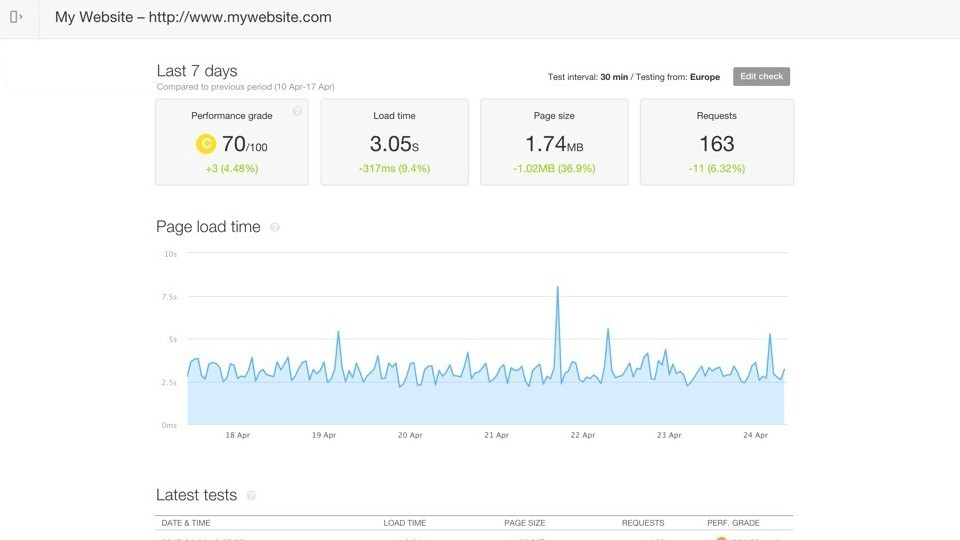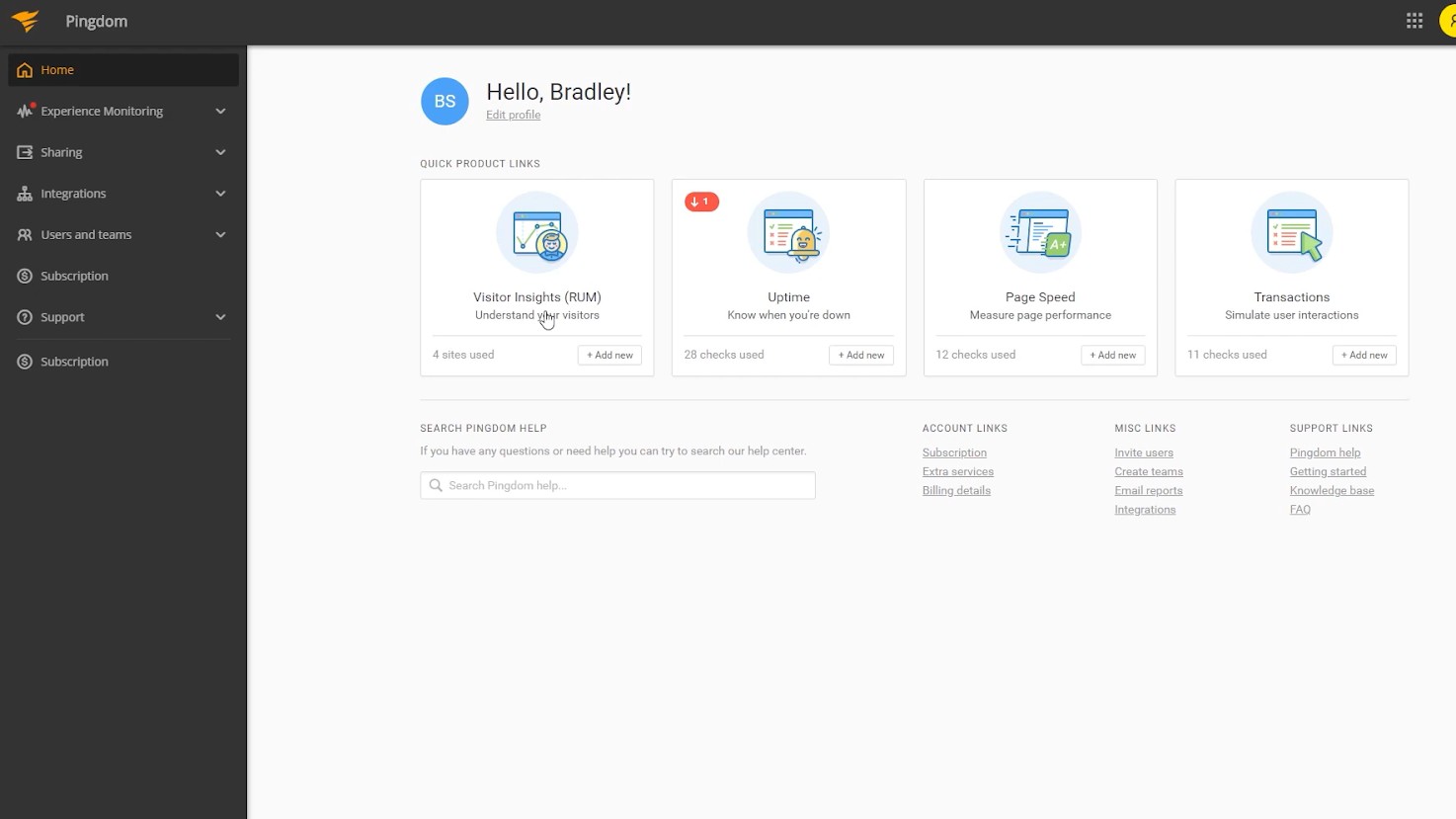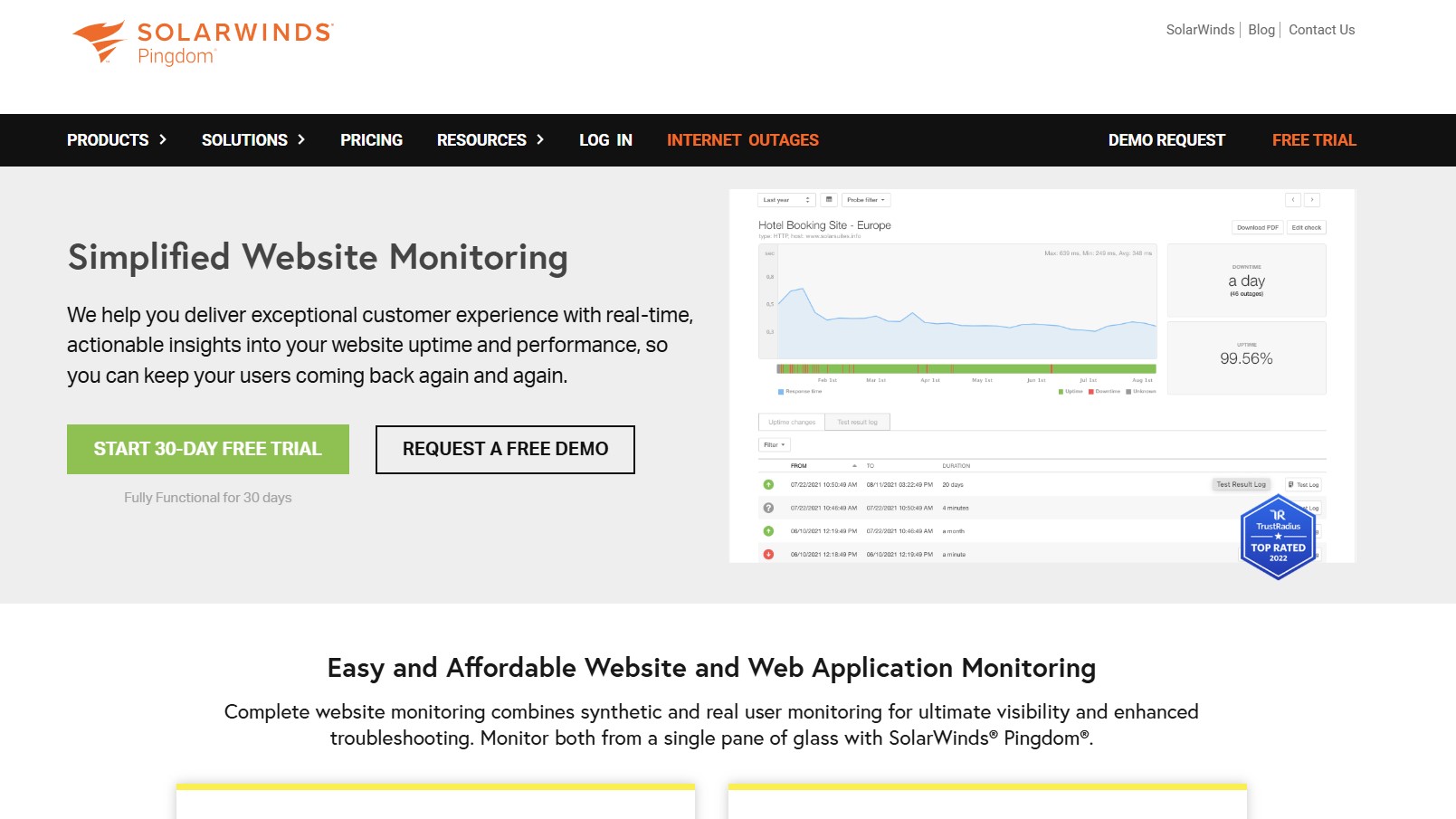TechRadar Verdict
Pingdom is one of the best website monitoring solutions thanks to features like uptime monitoring, page speed checks, transaction monitoring, and real user monitoring. Its dashboards are pretty data-oriented, filled with charts and graphs, which makes it easier for admins to quickly identify and solve bottlenecks. You also get a lot of pricing options – from 10 monitors per month to as many as 30,000 monthly monitors. This makes Pingdom perfect for businesses of all sizes. There’s also a 30-day free trial to try it out risk-free.
Pros
- +
The dashboard is filled with charts and graphs
- +
Detailed element-wise page speed tests
- +
Robust real user monitoring solution
- +
Lots of plans to choose from
Cons
- -
Involves a bit of a learning curve
- -
Can be expensive for large businesses
Why you can trust TechRadar
Businesses today need to have a constant online presence, which is why website monitoring has become indispensable. As the name suggests, a website monitor keeps an eye on your web addresses and immediately notifies you if there’s any downtime.
Businesses may lose an average of $137-$437 for every minute their website is down. This is where website monitoring tools like Pingdom come in handy. Pingdom runs various uptime and speed checks for your websites and produces data-driven reports so that you can know which parts of your website need attention. You also get stats from real user experience, which helps you identify visitor attributes and overall trends.
Stick around until the end as we’ll explore Pingdom in more detail. We’ll discuss its best features, pricing plans, and in-use experience, besides suggesting a couple of alternatives.
Pingdom: Plans and pricing
Pingdom has kept its pricing pretty simple. There are just two feature-wise plans – Synthetic Monitoring and Real User monitoring. The Synthetic Monitoring plan starts at just $10/month for 10 uptime monitors, 1 advanced monitor (page speed or transaction checks), and 50 SMS alerts.
However, there are as many as 22 options to choose from within this plan with various numbers of monitors, going all the way up to 30,000 uptime monitors. This makes it ideal for businesses of all sizes, from small businesses to multinational mega businesses.
Besides uptime monitoring, this plan offers page speed monitoring, public status pages, alerts, and transaction monitoring. Regardless of the threshold limit you choose, you can add unlimited users, making it good for small teams.
Next is the Real User Monitoring plan starting at $10/month for 100,000 page views. Here too, you have 22 threshold limits to choose from, all the way up to 1 billion pageviews. We love that there’s no limit on the number of sites you can run RUM on and users you can add.
Now, you can choose both these plans simultaneously in any permutation and combination as per your needs, giving you a lot of flexibility. Pingdom also offers a 30-day free trial to test out the platform before committing to a plan.
Pingdom: Features
Uptime monitoring is one of Pingdom’s core features. It keeps an eye on your websites and sends you instant notifications in case of outages. You can choose the mode as well as the frequency of the alerts. For example, critical alerts might require instant notifications, whereas minor issues may be notified an hour later.
Pingdom goes a step ahead and runs a detailed root cause analysis to find out what exactly went wrong. For every incident, administrators can run a traceroute, identify the output from a web server, and analyze response codes from servers. This helps in quick incident resolution.

Pingdom’s page speed checks are also different from other monitoring solutions. In addition to checking the page load times, Pingdom also examines how various elements like HTML, CSS, Javascript, and images are performing in relation to each other.
It also lets you zero in on the exact element that is slowing down your website. Pingdom’s comprehensive visualizations let you see how changes made on a page affect its speed. The platform assigns performance grades to each test so that you can know at just a glance how your pages have been performing.
Pingdom also comes with a simple transaction web recorder that lets you record a transaction for a check instead of having to code it manually. This makes it easy for non-IT teams to quickly monitor various parts of the customer journey on the website. For instance, you can run tests for simple actions like clicking a button, filling out a form, new user registrations, user login, or even completing payment on the website.
Besides all these synthetic monitoring features, Pingdom also offers a pretty comprehensive Real User Monitoring (RUM) function. RUM monitoring offers detailed insights into how real users access and interact with your website.
This helps you find out where customers spend most of their time on your website with the help of metrics like bounce rates, top browsers, active sessions, and top-visited pages.
Pingdom: Interface and in use
Pingdom’s interface is pretty data-driven, laced with various charts and graphs that help you understand your website performance metrics better. For instance, the top-level dashboards give you a quick summary of how different websites are performing.

To dig deeper, you can switch to the page-level metrics that focus on specific pages like checkout pages, signup pages, or your blog. Plus, every test and report on Pingdom is color-coded so that you can quickly identify any problems.
For instance, if you’re using RUM, you’ll see a live global map with areas marked in different colors, indicating load times in those regions. What's more, there are detailed timelines with vertical bar graphs for each check you run.
Getting started with the platform isn’t complex at all. You can add a new check in a matter of minutes, for instance. Moreover, there are a lot of help videos on the platform that guide you through the entire setup process.
Pingdom: Support
Pingdom has a dedicated customer portal for technical support, customer service, or product assistance. Here, you can raise a support ticket for any queries you might have. You can even set a priority for the issue you’re facing to get a quicker response.
Plus, you can even reach out to them on call between 8 am and 5 pm Central Time. They have dedicated phone numbers for the US, the UK, and SE regions.
Besides this, there are a lot of resource videos and help articles on the website that solve almost all beginner-level queries you might have.
Pingdom: The competition
HostTracker is a more affordable solution, allowing you to run 25+ URL uptime checks at just $18/month. Plus, you can add additional website checks for just $0.50/month. HostTracker also checks the IP DNS blacklist checker and Google's unsafe websites list to check if any of your websites have been blacklisted for any reason.
Plus, you can run comprehensive database checks along with transaction and speed checks. However, it lacks Real User Monitoring and status pages.
Uptime.com is another website monitoring tool very similar to Pingdom with features like cloud status checks and group checks. It also offers more than 20 types of basic checks, such as SMTP, NTP, UDP, and POP – something you don’t get with most other platforms.
You can run checks from unlimited global locations with as many as 15 locations per check and private location checks. However, Uptime.com is more expensive than Pingdom.
Pingdom: Final verdict
Pingdom is one of the most complete website monitoring tools you’ll ever come across, offering everything you need. It checks for website uptime with detailed root cause analysis and also has a robust speed check feature. Its Real User Monitoring capabilities help you drill down on real-user metrics with parameters like Apdex score, time to first byte, load time, and bounce rates.
The best thing about Pingdom is its visually graphic dashboards. You’ll find a lot of color-coded charts, maps, and graphs, which makes it easy to identify any bottlenecks. Regardless of the plan you choose, you can invite unlimited users to share these detailed and customizable reports with.
Pingdom also gives you a lot of plan options to choose from – 22 tiers each for synthetic and RUM monitoring. This makes it ideal for both small and large businesses. Last but not least, you get a 30-day free trial to try out before committing.
FAQs
Who is Pingdom best for?
Pingdom is a comprehensive website monitoring tool, ideal for businesses of all sizes. Firstly, it offers every monitoring feature you may need. From synthetic monitors like uptime, page speed, and transaction checks to complex real-user monitoring, Pingdom covers all bases.
Secondly, it has separate plans for synthetic and real user monitoring with 22 pricing tiers in each plan. Every tier has its own limit on the number of checks you can use. For example, if you want to run only 10 uptime checks, you’ll have to pay $10/month. The plans go all the way up to 30,000 uptime checks, making Pingdom a popular choice for businesses of all sizes.
What is the difference between website monitoring and content monitoring?
A website monitor examines various components of a website through tests like HTTPS, Ping, and TCP ports to ensure the address is online and notifies admins if there’s any downtime.
Content monitoring is an alerting mechanism that notifies users whenever there’s any change in the content of a specific website. For instance, businesses need to constantly monitor their competitors’ websites to track any developments.
Krishi covers buying guides and how-to's related to software, online tools, and tech products here at TechRadar. Over at Tom's Guide, he writes exclusively on VPN services. You can also find his work on Techopedia and The Tech Report. As a tech fanatic, Krishi also loves writing about the latest happenings in the world of cybersecurity, AI, and software.
You must confirm your public display name before commenting
Please logout and then login again, you will then be prompted to enter your display name.
